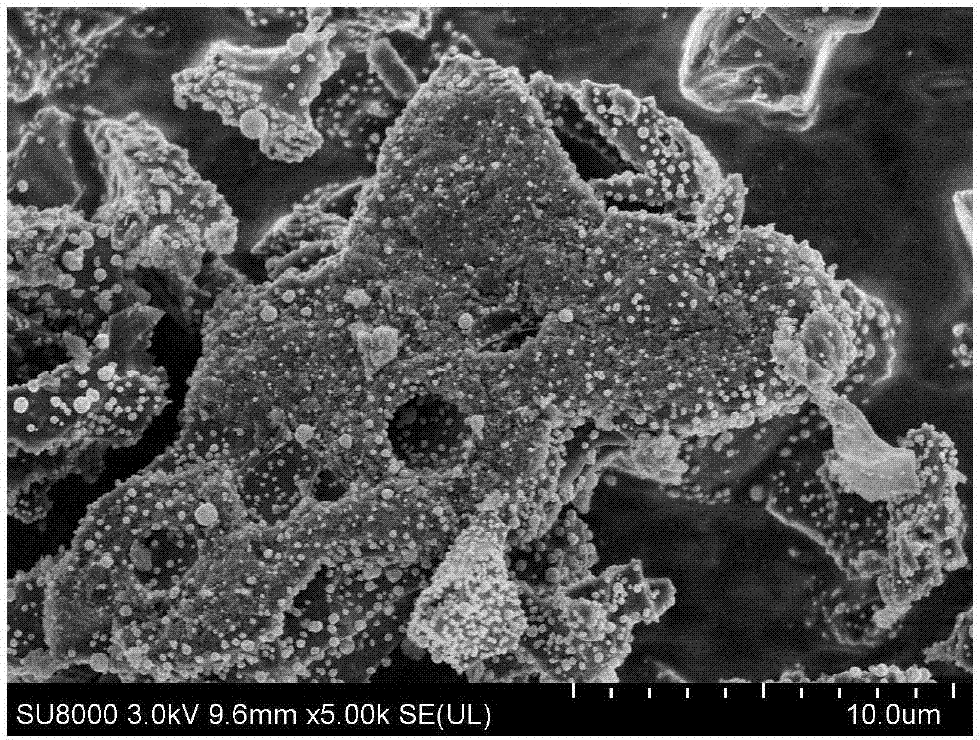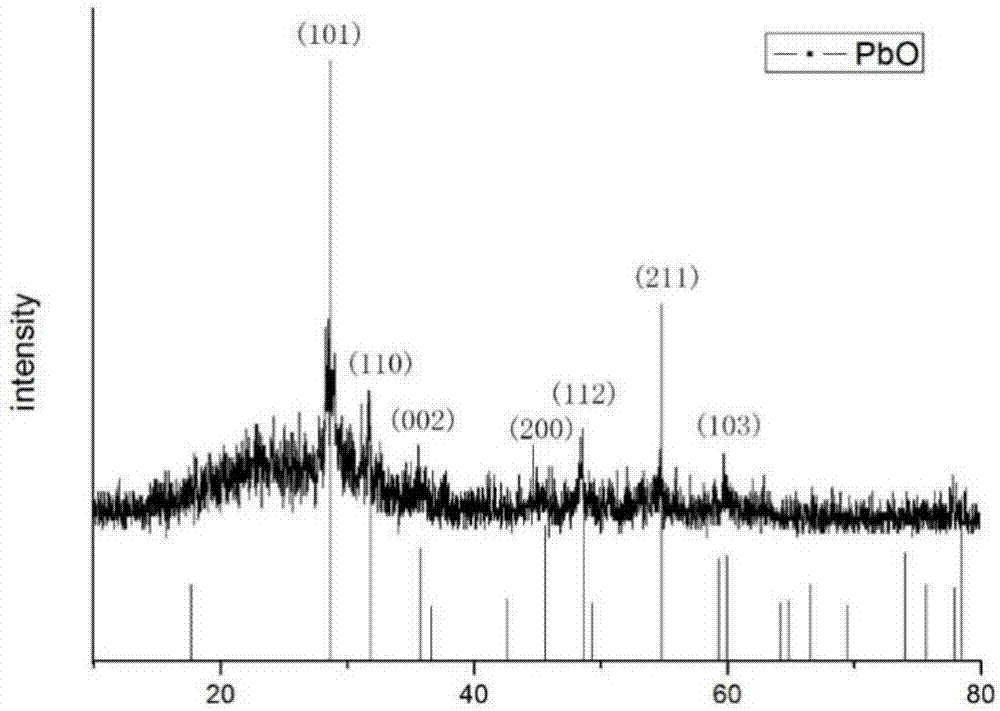Preparation method of carbon-based composite material for cathode of lead-carbon battery
A technology of carbon-based composite materials and lead-carbon batteries, which is applied to battery electrodes, circuits, electrical components, etc., can solve the problems of material limitation, reduce the problem of hydrogen evolution, and serious carbon materials, and achieve uniform surface distribution, uniform size, and utilization rate-enhancing effect
- Summary
- Abstract
- Description
- Claims
- Application Information
AI Technical Summary
Problems solved by technology
Method used
Image
Examples
Embodiment 1
[0030] (1) Add 10.0g of rice husk-based capacitor carbon material and 860ml of 0.1mol L into the beaker -1 lead nitrate solution, after stirring for 20min to mix uniformly, obtain a uniformly dispersed mixed solution;
[0031] (2) Slowly add 0.05mol L dropwise to the mixed solution described in (1) -1 Sodium hydroxide solution to completely precipitate lead on the surface of the carbon material, filter under reduced pressure, wash with absolute ethanol and deionized water three times, and dry in a blast drying oven at 60°C for 8 hours to obtain the precursor material;
[0032] (3) Put the precursor material described in (2) in a 380°C tube furnace N 2 Treat under protection for 5 hours to obtain the final black composite material.
[0033] (4) Use the composite material obtained in the above (3) as an additive to prepare the negative electrode of the battery and combine it with PbO 2 The battery is assembled with the positive plate, using AGM separator as the diaphragm, and...
Embodiment 2
[0036] (1) Add 10g of rice husk-based capacitor carbon material and 860ml of 0.025mol L into the beaker -1 lead nitrate solution, after stirring for 30min to mix uniformly, obtain a uniformly dispersed mixed solution;
[0037] (2) slowly drop 0.025mol L into the mixed solution described in (1) -1 Sodium hydroxide solution, so that the lead-containing compound is deposited on the surface of the carbon material to precipitate completely, filtered under reduced pressure, washed repeatedly with absolute ethanol and deionized water for 3 times, and dried in a blast drying oven at 60°C for 8 hours to obtain the precursor material;
[0038] (3) Treat the precursor material described in (2) in a tube furnace at 380° C. for 5 hours to obtain the final black composite material.
[0039] (4) Use the composite material obtained in the above (3) as an additive to prepare the negative electrode of the battery and combine it with PbO 2The battery is assembled with the positive plate, using...
Embodiment 3
[0042] (1) Add 10g of rice husk-based capacitor carbon material and 860ml of 0.005mol L into the beaker -1 lead nitrate solution, after stirring for 30min to mix uniformly, obtain a uniformly dispersed mixed solution;
[0043] (2) slowly drop 0.001mol L into the mixed solution described in (1) -1 Sodium hydroxide solution, so that the lead-containing compound is deposited on the surface of the carbon material to precipitate completely, filtered under reduced pressure, washed repeatedly with absolute ethanol and deionized water for 3 times, and dried in a blast drying oven at 60°C for 8 hours to obtain the precursor material;
[0044] (3) Treat the precursor material described in (2) in a tube furnace at 380° C. for 5 hours to obtain the final black composite material.
[0045] (4) Use the composite material obtained in the above (3) as an additive to prepare the negative electrode of the battery and combine it with PbO 2 The battery is assembled with the positive plate, usin...
PUM
| Property | Measurement | Unit |
|---|---|---|
| particle size (mesh) | aaaaa | aaaaa |
| capacitance | aaaaa | aaaaa |
Abstract
Description
Claims
Application Information
 Login to View More
Login to View More - R&D
- Intellectual Property
- Life Sciences
- Materials
- Tech Scout
- Unparalleled Data Quality
- Higher Quality Content
- 60% Fewer Hallucinations
Browse by: Latest US Patents, China's latest patents, Technical Efficacy Thesaurus, Application Domain, Technology Topic, Popular Technical Reports.
© 2025 PatSnap. All rights reserved.Legal|Privacy policy|Modern Slavery Act Transparency Statement|Sitemap|About US| Contact US: help@patsnap.com



